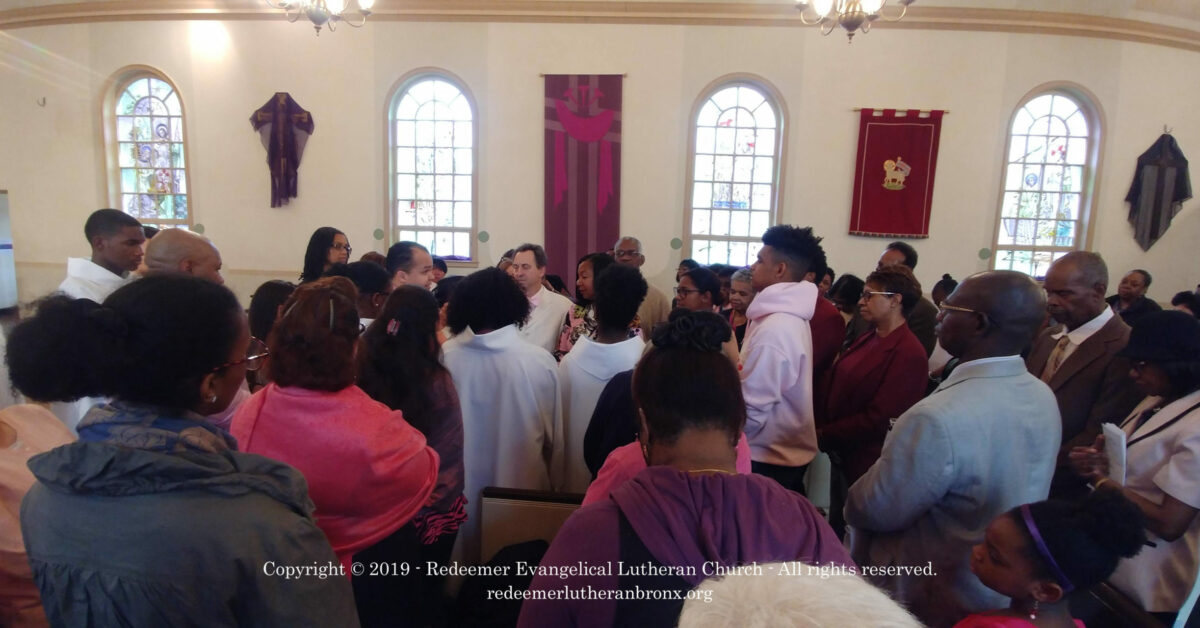A Ritual Journey: The First Scrutiny
The first ritual practice following election in the RCIA is the First Scrutiny. There are three scrutinies in the Period of Enlightenment on the 3rd, 4th, and 5th Sundays in Lent. The Lutheran resources provide fewer aids toward scrutiny rites. Welcome to Christ provides a renunciation of evil on the 4th Sunday in Lent and Go Make Disciples advocates for public rites of blessing throughout Lent that support the “candidates in renouncing evil in their lives” (116).
The title “scrutinies” is unfortunately misleading. It appeals back to fourth century practice when the Christian community examined the elect’s commitment toward becoming disciples of the Lord Jesus Christ through baptismal initiation and to engage spiritual warfare against sin and evil. But the scrutinies in the RCIA are not primarily intensive examinations of the elects’ lives. The orientation and purpose of the scrutinies in the modern RCIA is for the elect to “renounce sin and evil and profess faith in the Triune God at their baptism” (Guide, 58)
These scrutinies are rites of purification as the elect learn about sin, especially their own, and the Holy Spirit elicits in them the desire to be delivered from sin and evil. As the RCIA says, they are
“to uncover, then heal all that is weak, defective, or sinful in the hearts of the elect; to bring out, then strengthen all that is upright, strong, and good. For the scrutinies are celebrated in order to deliver the elect from the power of sin and Satan, to protect them against temptation, and to give them strength in Christ, who is the way, the truth, and the life” (RCIA, 78).
Guide for Celebrating Christian Initiation with Adults calls them “rites of self-searching and repentance” (59). The rites and catechesis throughout this period promote among the elect genuine self-knowledge. As Ronald Lewinski says of the scrutinies,
“God’s Word searches our hearts and scrutinizes our values and way of life. This scrutinizing begins outside the formal rites—throughout Lent and long before—as the elect search their lives in the light of the Gospel and so identify the falsehoods that keep them from embracing the Kingdom of God as their way of life” (An Introduction to the RCIA, 54).
This self-examination and repentance includes attending to both personal and social sin. Personal sin would include “long-standing grudges, selfishness, poor health habits, personal prejudices, addictions to social media” and social sin would include “materialism, consumerism, sexism, racism, militarism, hedonism, and idolatry” (54).
As with most rites in the catechumenate, the elect are the primary symbol. They gather, along with their sponsors, at the front of the nave facing the assembly with their sponsors standing behind them. All three scrutinies follow the same pattern within the divine service:
- Readings from Series A (woman at the well, the man born blind, and the raising of Lazarus, seeking to illuminate the lives of the elect)
- Homily (which includes exploration of the meaning of the scrutiny)
- Silent prayer by the presider, sponsors, elect, and the assembly
- Intercessions for the elect
- Exorcism Prayer
- [Psalm/Hymn/Song]
- Dismissal of the elect
The exorcisms are not rites for casting out a demonic spirit (aka. The Exorcist). Rather, they are prayers of spiritual warfare. In the RCIA there are two prayers, the first addressed to God the Father and the second addressed to Jesus Christ. The presider prays the first prayer with hands outstretched over all of the elect. The presider then lays hands on the head of each of the elect individually in silence. Sponsors are also encouraged to lay a hand or hands on the shoulders of the elect. The assembly also may extend their hands over the elect. The presider then prays the second prayer over all of the elect. The text of the exorcism prayers are general in nature, as seen in the first prayer for Lent 3:
“God of power, you sent your Son to be our Savior. Grant that these catechumens, who, like the woman of Samaria, thirst for living water, may turn to the Lord as they hear his word and acknowledge the sins and weaknesses that weigh them down. Protect them from vain reliance on self and defend them from the power of Satan. Free them from the spirit of deceit, so that, admitting the wrong they have done, they may attain purity of heart and advance on the way to salvation” (RCIA Study Edition, 84).
Setting aside some language that Lutherans might wish to change, these exorcistic prayers encourage the elect to identify and name their own sins and proclivities toward and participation in evil. They also indicate to the Christian assembly the desire to participate as well in such renunciation of sin and evil. Ultimately the scrutinies are rites of liberation from sin, evil, and the power of satan.
